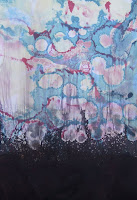It's Friday and the shop is empty....hmmmm. It's a beautiful day for printing. We will be spending some time looking at our prints at the beginning of class on Monday, seeing where we are with the form and getting a sense of whatever content is there. Most of the current impressions are yellow, a bright yellow. I don't know if that content expresses insanity as much as it expresses yellow. Don't be afraid to make marks, create textures, roll some ink on your mylar, put on an old pair of pants, and sit in the ink. Is that insane?
Form is the physical manifestation of a work of art that includes the media, such as yellow ink on white paper, the manipulation and arrangement of the visual components, such as yellow shapes creating white shapes on white paper, and the subject matter as it is treated as components, such as yellow and white shapes on white paper. It is what the work looks like. So I guess we can discuss yellow and white shapes. THAT'S INSANE! There are a few that have gone beyond that, only a few.
Content is the message the you intend to communicate = INSANITY. It could be found in the subject matter, Shawn mentioned Munch's, The Scream, a kind of narrative that tells a story. It may be emotional or intellectual and could include the way the media is manipulated if that manipulation is driven by an idea, like Chris' juxtaposed symbols of the pyramid and the other thing, whatever that thing is, or even Rob's current investigations of surface and materials. Jackson Pollock, you know him, you know his work, made paintings with a particular idea about painting in mind. Not about an image but about a process. The way your work is created will become an important part of the content and should be clearly seen in the finished piece, or maybe not so clear. INSANITY, as mentioned before in some obtuse way, could very much tap into the OCD part of us. Imagine a color filed of yellow filled with dots, over printed with a color field of Cyan filled with dots, over printed with a color field of magenta filled with dots....that's INSANE!
Almost every monotype on the drying rack, even at this early stage, has both form and content. Even when they're finished they'll have both, but surely and not likely in equal amounts. How would we even measure that? That would be an insane exercise. It's actually a continuum where each monotype, or each piece you create, falls on a line that runs the gamut between being purely formal, think of those Josef Albers' yellow squares, to purely content, such as Basquiat, although both of these artists still have varying degrees of form and content. Or better yet, the work by conceptual artists, their artwork was/is about ideas, maybe a better analogy referencing purely content. Conceptual art had/has very little physicality and thus nearly no form. Push your form/content into an insane place, and....
Happy printing.

















































